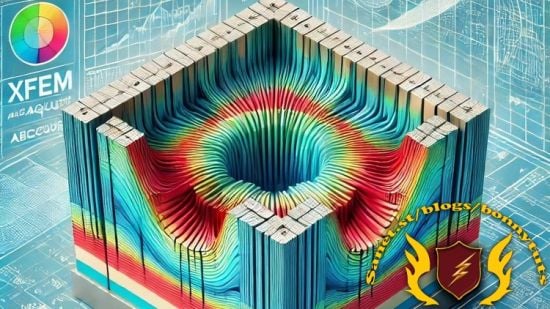
Published 8/2024
Created by Atef Framawy
MP4 | Video: h264, 1280×720 | Audio: AAC, 44.1 KHz, 2 Ch
Genre: eLearning | Language: English | Duration: 28 Lectures ( 2h 58m ) | Size: 1.7 GB
Fatigue Crack Growth Using XFEM Method With Paris Law In ABAQUS (Direct cyclic Low cycle fatigue approach)
What you’ll learn:
Introduction to fracture mechanics (theory)
Finite element method (FEM) and Extended finite element method (XFEM) ((theory))
Fatigue crack growth (theory)
ABAQUS general explanation
fatigue model creation “how to define the XFEM, how to implement Paris law, define the pre-crack length & location, direct cyclic and how to control accuracy.
Three different case studies
how to deal with stationary cracks to calculate fracture mechanics parameters like SIF.
Requirements:
only the basic knowledge of material properties. as the course content contains the basis for fracture mechanics, FEM and ABAQUS explanation from zero
Description:
Fatigue represents the most common cause of mechanical structure failures. To investigate this phenomenon, studies have conducted experiments, conducting actual fatigue experiments demands extensive time, substantial financial resources, and is constrained by size limitations. The solution lies in the development and validation of precise numerical models. This is the primary driver behind our course, as it enables accurate and reliable predictions of crack growth. This course delves into the advanced simulation of fatigue crack growth using the eXtended Finite Element Method (XFEM) combined with the Paris Law formulation, fully implemented in ABAQUS software. The course emphasizes the direct cyclic and low cycle fatigue approaches, providing a comprehensive framework for analyzing the degradation of materials under cyclic loading.You Will Learn:1. Fundamentals of fracture mechanics and Fatigue Crack Growth:2. Finite Element Method (FEM) and eXtended Finite Element Method (XFEM) – Core principles of FEM and how they apply to crack propagation simulations. – Coverage of XFEM, including enrichment functions, and level-set methods. – How to model cracks without remeshing the mesh during propagation and how XFEM handles discontinuities.3. Fatigue Crack Propagation Regimes: – Understanding the relationship between crack size and cycles, including factors like stress ratio effects. – Detailed exploration of crack growth laws, including Paris Law, Walker Law, and NASGRO formulations. – Methods for life prediction, failure criteria, and assessing the factor of safety in fatigue analysis.4. Model Creation in ABAQUS: – Step-by-step guidance on part creation and material definition, including damage models for traction separation. – Implementation of direct cyclic and low cycle fatigue steps, focusing on Fourier representations, and convergence criteria. – Special interaction properties like pre-crack definitions and Paris Law implementation for fatigue analysis.5. Results Interpretation and Post-Processing: – Visualizing crack propagation patterns across different cycles. – Generating and analyzing key outputs such as crack length vs. cycle graphs and fatigue crack growth rates (da/dN vs. ΔK).6. Three different case studies.Course Features:- Detailed theoretical background paired with practical modeling exercises in ABAQUS.- Real-world case studies and examples, including complex geometries.- Guidance on setting up simulations for brittle materials using LEFM principles.Who Should Enroll:This course is designed for engineers, researchers, and under graduate or graduate students who wanted to get a very good understanding of finite element analysis and wish to expand their knowledge in the field of fracture and fatigue analysis using ABAQUS. It is particularly beneficial for those interested in crack growth modeling and the application of advanced methods like XFEM and direct cyclic analysis in practical engineering scenarios.By the end of the course, participants will be able to simulate, analyze, and interpret fatigue crack growth in various materials and loading conditions, providing them with a competitive edge in the field of structural analysis and design.
Password/解压密码www.tbtos.com
转载请注明:0daytown » ABAQUS learning: Fracture & Fatigue theory & implementation